Enterprise Routing and Switching, Specialist (JNCIS-ENT) v7.0
Question 1
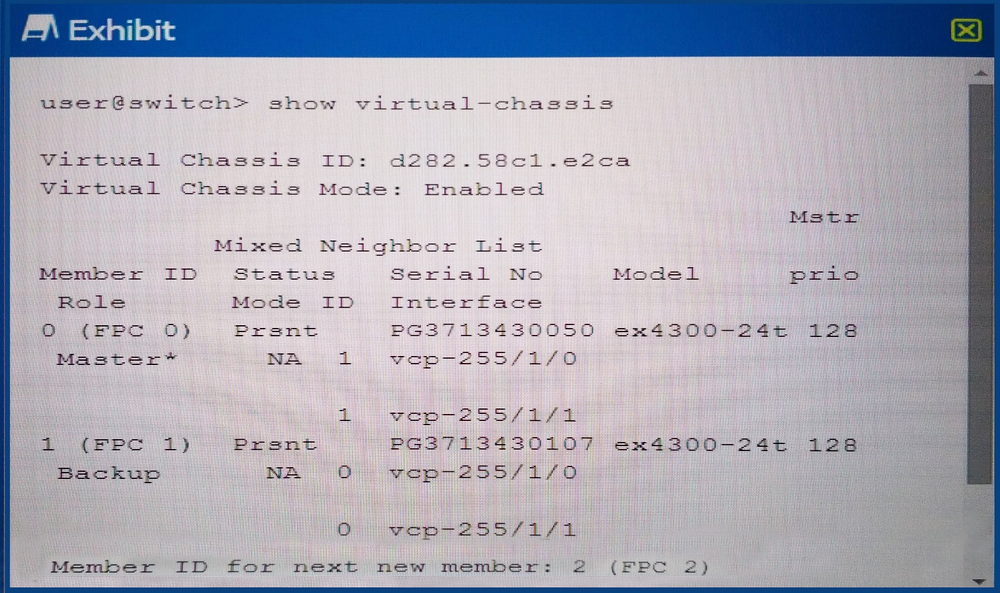
Click the Exhibit button.
Given the information shown in the exhibit, what was used to determine mastership?
- A. member uptime
- B. manuallyassigned role
- C. highest serial number
- D. manually assigned priority
Answer : A
Explanation:
When a Virtual Chassis configuration boots, the Juniper Networks Junos operating system
(Junos OS) on the switches automatically runs a master election algorithm to determine which member switch assumes the role of master.
The algorithm proceeds from the top condition downward until the stated condition is satisfied:
Question 2
Which two statements are true about OSPF not-so-stubby areas? (Choose two.)
- A. The ASBR originates Type 7 LSAafor redistributed external routes.
- B. Type 5 LSAs are translated by the ASBR into Type 7 LSAs.
- C. The ASBR originates Type 5 LSAs for redistributed external routes.
- D. Type 7 LSAs are translated by the ABR into Type 5 LSAs.
Answer : A,D
Explanation:
Redistribution intoan NSSA area creates a special type of link-state advertisement (LSA) known as type 7, which can only exist in an NSSA area. An NSSA autonomous system boundary router (ASBR) generates this LSA and an NSSA area border router (ABR) translates it into a type5 LSA, which gets propagated into the OSPF domain.
References:http://www.cisco.com/c/en/us/support/docs/ip/open-shortest-path-first- ospf/6208-nssa.html
Question 3
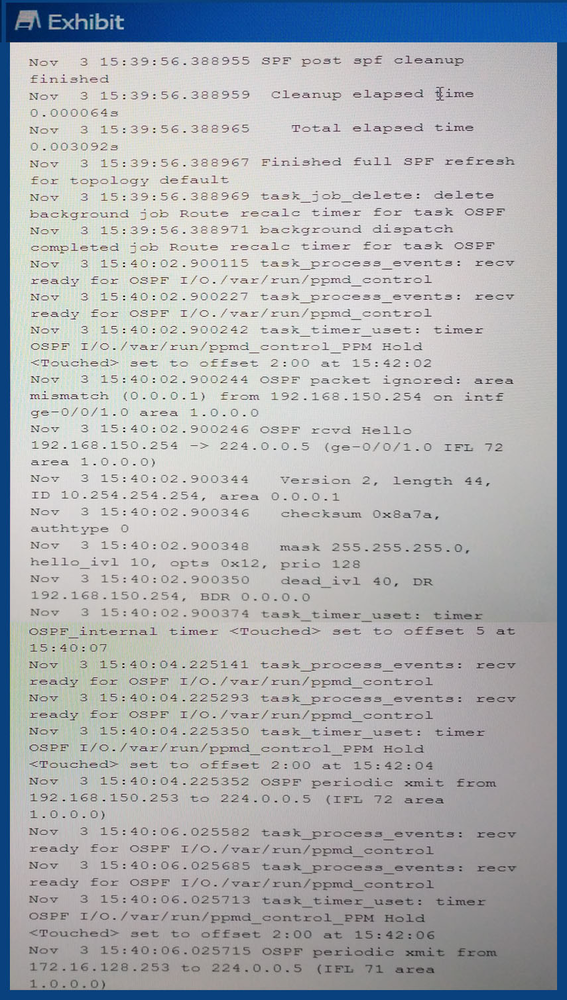
Click the Exhibit button.
Based on the traceoptions output shown in the exhibit, what is the problem with the adjacency?
- A. connectivity
- B. authentication mismatch
- C. area mismatch
- D. MTU mismatch
Answer : C
Explanation:
From the exhibit we see:
OSPF packet ignored: area mismatch
Question 4
Which three link-specific fields must match between OSPF neighbors before they form an adjacency over a broadcast medium? (Choose three.)
- A. dead interval
- B. options
- C. hello interval
- D. neighbor
- E. router priority
Answer : ACD
Explanation:
AC: If OSPF HELLO or Deadtimer interval values are mismatched, then adjacency cannot be achieved.
D: In a successful formation of OSPF adjacency, OSPF neighbors will attain the FULL neighbor state.
References:http://www.cisco.com/c/en/us/support/docs/ip/open-shortest-path-first- ospf/13699-29.html
Question 5
What is reviewed first in the BGP route selection process?
- A. the peerwith the lowest IP address
- B. the route with an origin of incomplete
- C. the path with no MED value
- D. the next-hop resolution
Answer : D
Explanation:
Understanding BGP Path Selection
The algorithm for determining the active route is as follows:
Etc.
References:https://www.juniper.net/documentation/en_US/junos12.3/topics/reference/gene ral/routing-ptotocols-address-representation.html
Question 6
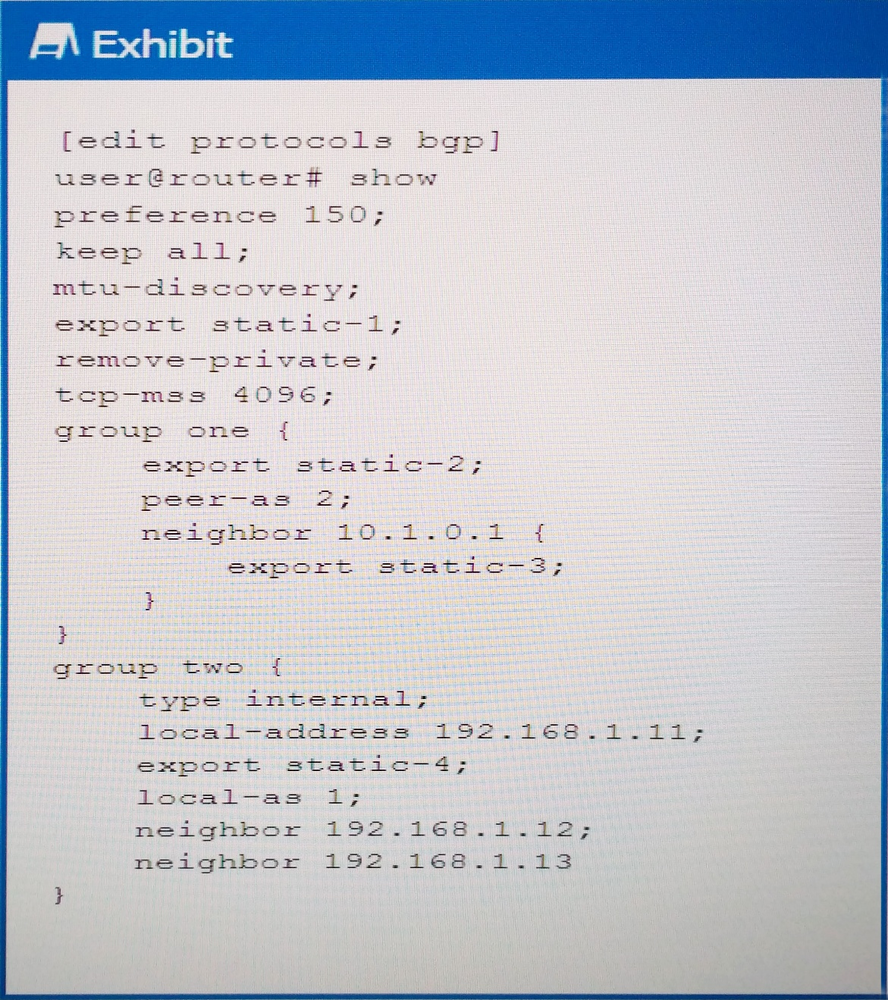
Click the Exhibit button.
Referring to the exhibit, which policy will export routes to IBGP peers?
- A. static-4
- B. static-1
- C. static-3
- D. static-2
Answer : A
Explanation:
Type internal in group two indicates refers to an IBGP route.
References:www.juniper.net/documentation/en_US/junos13.3/topics/topic-map/bgp-ibgp- peering.html
Question 7
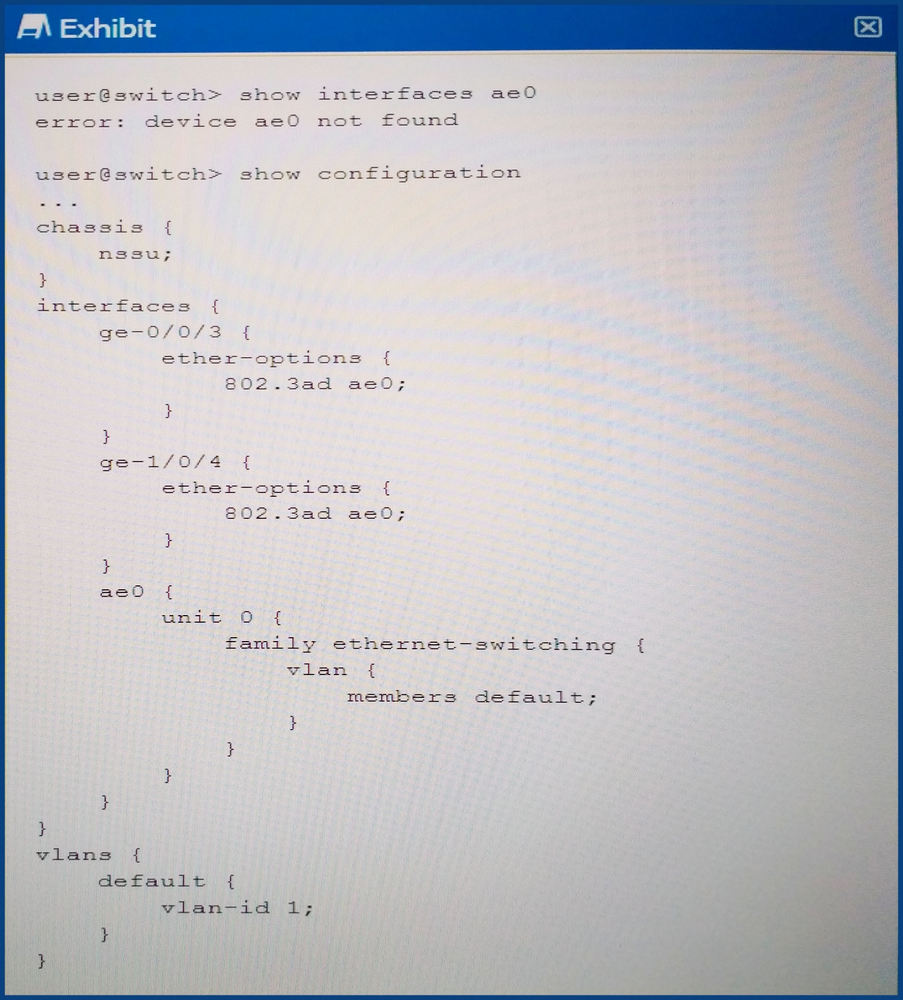
Click the Exhibit button.
Referring to the exhibit, what is the problem?
- A. LAG requires more than two member links.
- B. LACP is required for LAG to work.
- C. Aggregated interfaces must be defined under the chassis stanza.
- D. The LAG member interfaces are configured across different line cards.
Answer : C
Explanation:
Use the link aggregation feature to aggregate one or more links to form a virtual link or link aggregation group (LAG).
To configure aggregated Ethernet interfaces, using the CLI:
Question 8
Which protocol supports tunneling of non-IP traffic?
- A. GRE
- B. SSH
- C. IPsec
- D. IP-IP
Answer : A
Explanation:
The GRE protocol (Generic RoutingEncapsulation) which is a tunneling protocol that can encapsulate a variety of network layer packet types into a GRE tunnel. GRE therefore can encapsulate multicast traffic, routing protocols (OSPF, EIGRP etc) packets, and other non-
IP traffic inside a point-to-point tunnel.
References:http://www.networkstraining.com/passing-non-ip-traffic-over-ipsec-vpn-using- gre-over-ipsec/
Question 9
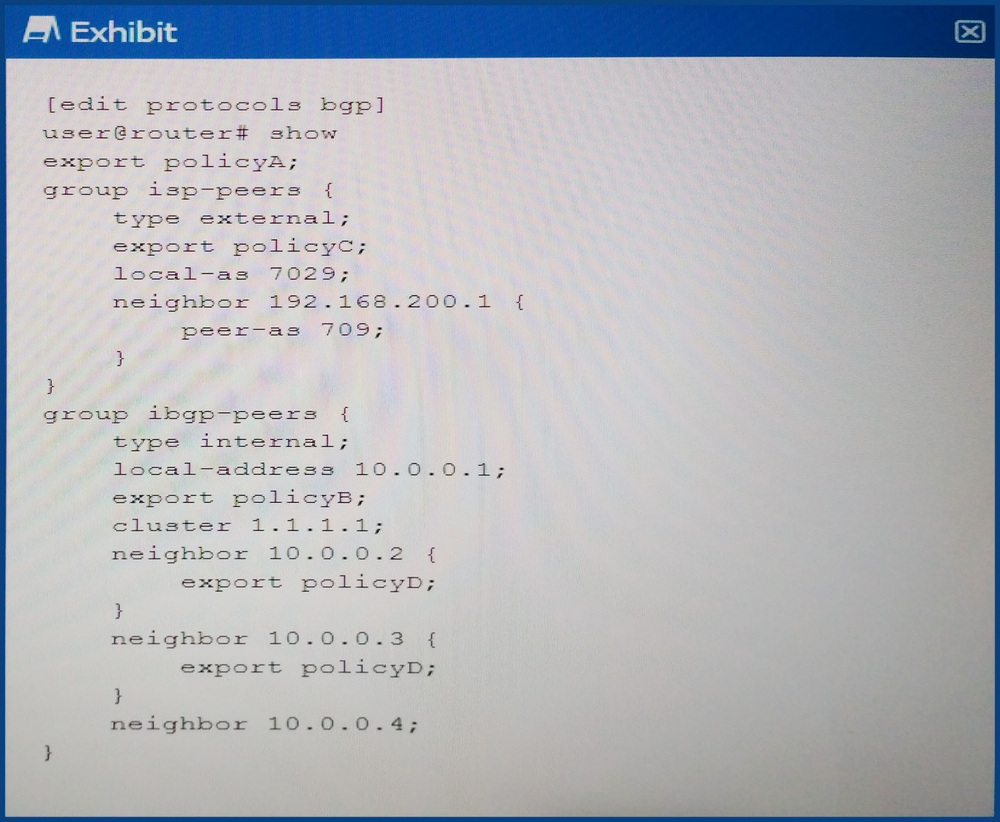
Click the Exhibit button.
Referring to the exhibit, which two statements are true?
- A. ThepolicyArouting policy takes precedence over all other policies.
- B. No policy is used for neighbor 10.0.0.4.
- C. ThepolicyBrouting policy is used by neighbor 10.0.0.4.
- D. ThepolicyDrouting policy is the only policy used by neighbor 10.0.0.2.
Answer : CD
Explanation:
C: A group-level import or export statement, such as export policyB within the group ibgp- peers statements, overrides a global BGP import or export statement. It is applied to neighbor 10.0.0.4.
Question 10
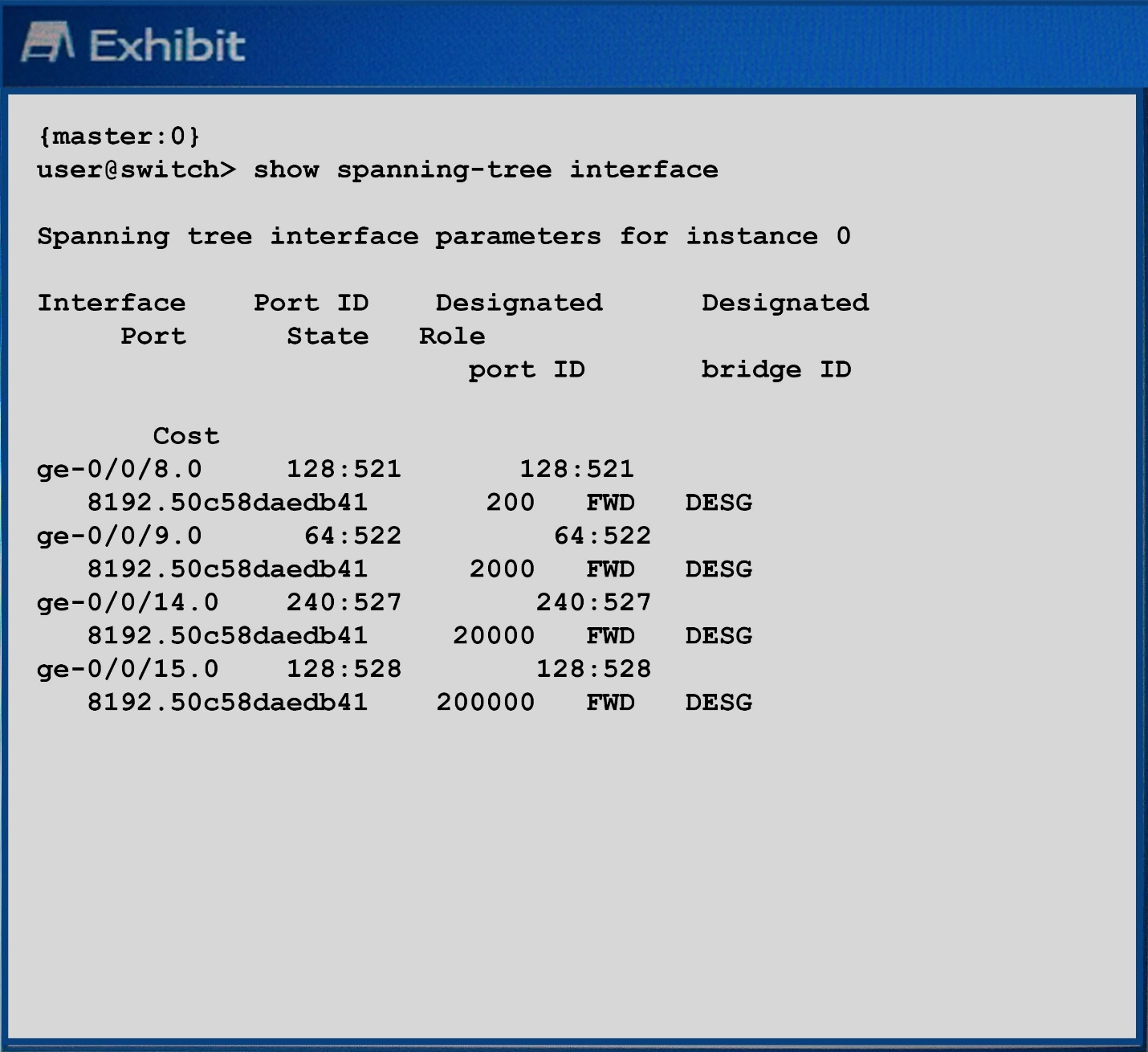
Click the Exhibit button.
Based on the output shown in the exhibit, which statement is correct?
- A. The ge-0/0/9 interface is using the default priority value.
- B. The ge-0/0/15 interface is usingthe default port cost.
- C. This switch has a bridge priority of 32k.
- D. This switch has been elected as the root bridge.
Answer : B
Explanation:
The default port cost for a 100 Mbit/s interface is 200,000, which is the port cost of the ge-
0/0/15 interface.
Note: Data rate and default STP path cost
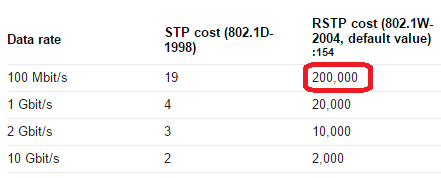
Question 11
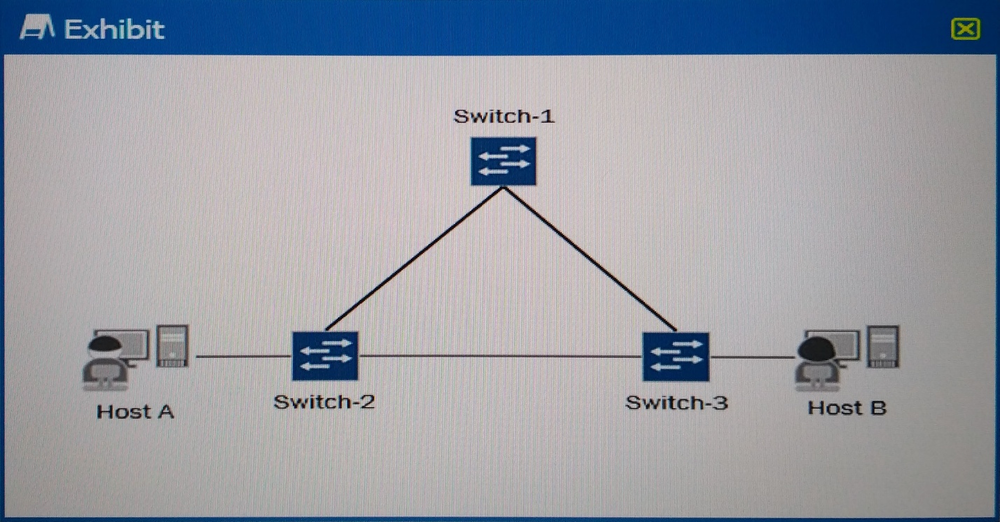
Click the Exhibit button.
A number of reports from end-users indicate that internal and external communications are intermittent and not reliable. You verified the status of the switch ports and have determined that they are up and operational. You also noticed a very high level of link bandwidth utilization on those same ports. The current topology of the affected environment is shown in the exhibit.
What would be the cause of the reported issues?
- A. A lack of port-based ACLs filtering the traffic flows.
- B. A lack of a loop-prevention mechanism or protocol.
- C. A malformed route-based ACL improperly filtering traffic flows.
- D. A misconfigured interior gateway protocol (IGP).
Answer : B
Explanation:
Enabling Spanning-Tree Protocol will mitigate loops, so ifpossible, enable Spanning-Tree
Protocol on the devices in the network segment where the loop is observed.
Question 12
Which two statements are correct regarding the root bridge election process when using
STP? (Choose two.)
- A. A higher system MAC address is preferred.
- B. A higher bridge priority is preferred.
- C. A lower system MAC address is preferred.
- D. A lower bridge priority is preferred.
Answer : CD
Explanation:
The root bridge for each spanning-treeprotocol (STP) instance is determined by the bridge
ID. The bridge ID consists of a configurable bridge priority and the MAC address of the bridge. The bridge with the lowest bridge ID is elected as the root bridge. If the bridge priorities are equal or ifthe bridge priority is not configured, the bridge with the lowest MAC address is elected the root bridge.
References:https://www.juniper.net/documentation/en_US/junos15.1/topics/concept/layer-
2-services-stp-guidelines-statement-bridge-priority.html
Question 13
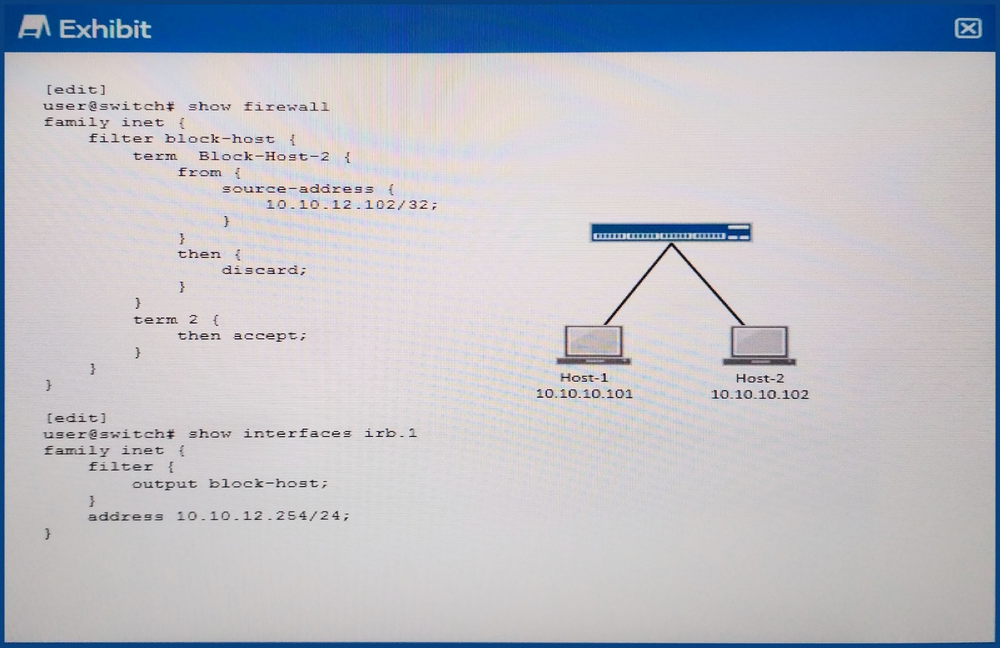
Click the Exhibit button.
The exhibit shows that Host-1 and Host-2 are attached to the switch and associated with
IRB irb.1. However, traffic sent from Host-1 to Host-2 is not blocked as expected.
Why is this problem occurring?
- A. Inter-VLAN traffic cannot be blocked by a router-based filter.
- B. Theblock-hostfilter is applied in the wrong direction on theirb.1interface.
- C. TheBlock-Host-2term does not contain the MAC address of Host-2.
- D. Intra-VLAN traffic cannot be blocked by a router-based filter.
Answer : B
Explanation:
Theblock-hostfilter blocks traffic with source address of 10.10.12.102, which is traffic sent from Host-2. It shouldblock traffic from Host-1, with the source address of of 10.10.12.101.
Question 14
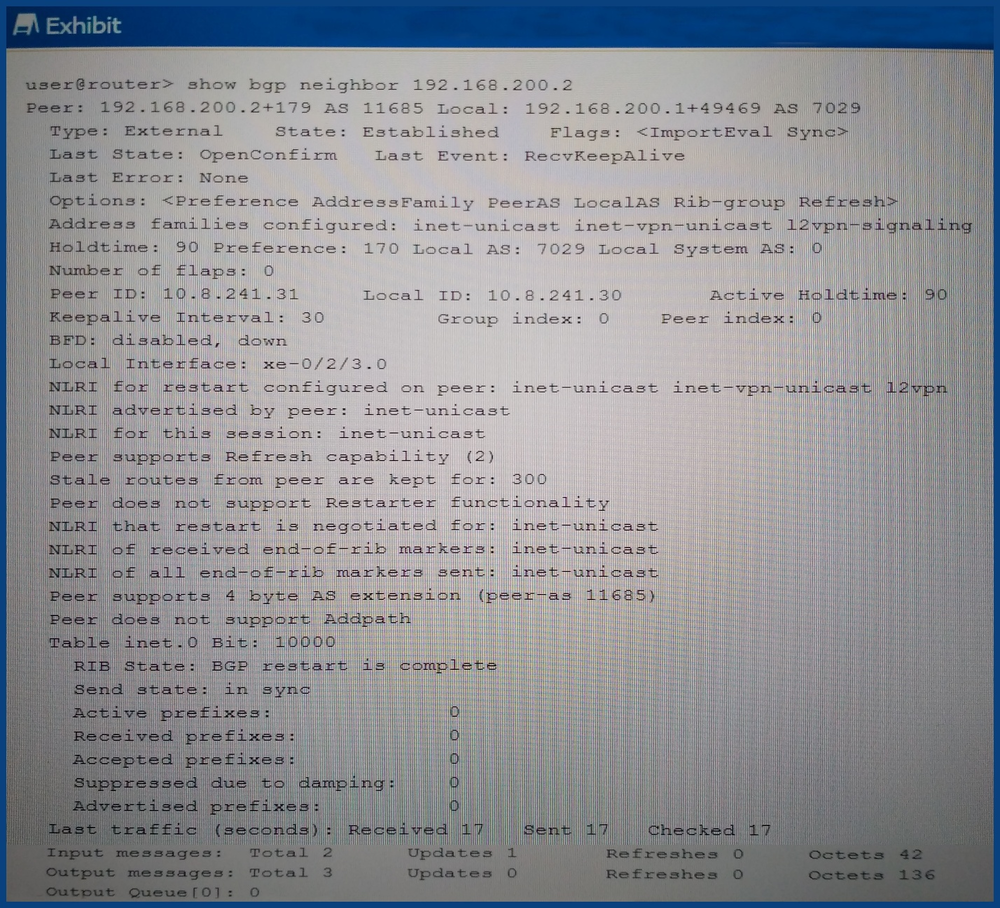
Click the Exhibit button.
Your router is configured to peer with your ISPs router using BGP. You can only control your BGP configuration.
Which address families are negotiated between the two BGP peers shown in the exhibit?
- A. inet-vpn-unicast
- B. inet-unicast inet-vpn-unicast 12vpn
- C. inet-unicast inet-vpn-unicast 12vpn-signaling
- D. inet-unicast
Answer : D
Explanation:
From the exhibit we see:
NLRI for restart configured on peer: inet-unicast inet-vpn-unicast 12vpn
But we also see:
NLRI that restat is negotiaded for: inet-unicast
NLRI of received end-of-rib markers: inet-unicast
NLRI of all end-of-rib markers sent: inet-unicast
Question 15
An OSPF hello packet has been sent, but bidirectional communication has not been established.
What is the state of the OSPF adjacency?
- A. Down
- B. Init
- C. Exchange
- D. Loading
Answer : A
Explanation:
Down is the first OSPF neighbor state. It means that noinformation (hellos) has been received from this neighbor, but hello packets can still be sent to the neighbor in this state.
Incorrect Asnwers:
B: The Init state specifies that the router has received a hello packet from its neighbor, but the receiving router's ID was not included in the hello packet.
References:http://www.cisco.com/c/en/us/support/docs/ip/open-shortest-path-first- ospf/13685-13.html